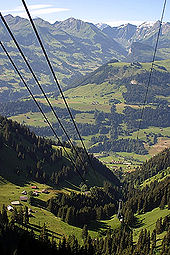Erlenbach im Simmental: Difference between revisions
Extended confirmed users, Pending changes reviewers 35,343 edits →Geography: update geography |
|||
| Line 33: | Line 33: | ||
==Geography== |
==Geography== |
||
[[File:Erlenbach Simmental.jpg|thumb|left|upright|Simmental]] |
[[File:Erlenbach Simmental.jpg|thumb|left|upright|Simmental]] |
||
Erlenbach has an area of {{km2 to mi2|36. |
Erlenbach im Simmental has an area, {{as of|2009|lc=on}}, of {{km2 to mi2|36.72|abbr=on}}. Of this area, {{km2 to mi2|18.56|abbr=on}} or 50.5% is used for agricultural purposes, while {{km2 to mi2|13.93|abbr=on}} or 37.9% is forested. Of the rest of the land, {{km2 to mi2|1.27|abbr=on}} or 3.5% is settled (buildings or roads), {{km2 to mi2|0.32|abbr=on}} or 0.9% is either rivers or lakes and {{km2 to mi2|2.6|abbr=on}} or 7.1% is unproductive land.<ref name=BFS_land>[http://www.bfs.admin.ch/bfs/portal/de/index/themen/02/03/blank/data/gemeindedaten.html Swiss Federal Statistical Office-Land Use Statistics] 2009 data {{de icon}} accessed 25 March 2010</ref> |
||
Of the built up area, housing and buildings made up 1.5% and transportation infrastructure made up 1.4%. 32.3% of the total land area is heavily forested and 5.3% is covered with orchards or small clusters of trees. Of the agricultural land, 0.8% is used for growing crops and 16.2% is pastures and 33.3% is used for alpine pastures. All the water in the municipality is in rivers and streams. Of the unproductive areas, 3.3% is unproductive vegetation and 3.7% is too rocky for vegetation.<ref name=BFS_land/> |
|||
The municipality includes the farming settlements (''[[Bäuerten]]'') of Erlenbach, Latterbach and Ringoldingen in the valley. On a terrace above the valley are the farming settlements (''Bäuerten'') of Balzenberg, Eschlen, Thal and Allmenden. Above these settlements there are woods and mountains. |
The municipality includes the farming settlements (''[[Bäuerten]]'') of Erlenbach, Latterbach and Ringoldingen in the valley. On a terrace above the valley are the farming settlements (''Bäuerten'') of Balzenberg, Eschlen, Thal and Allmenden. Above these settlements there are woods and mountains. |
||
Revision as of 00:09, 3 April 2010
Erlenbach im Simmental | |
|---|---|
Erlenbach, Zurich (Switzerland), Erlenbach am Main (Germany) | |
| Website | www SFSO statistics |

Erlenbach im
History
Erlenbach is first mentioned in 1180 as Arlunbach.[3]
Geography

Erlenbach im Simmental has an area, as of 2009[update], of Template:Km2 to mi2. Of this area, Template:Km2 to mi2 or 50.5% is used for agricultural purposes, while Template:Km2 to mi2 or 37.9% is forested. Of the rest of the land, Template:Km2 to mi2 or 3.5% is settled (buildings or roads), Template:Km2 to mi2 or 0.9% is either rivers or lakes and Template:Km2 to mi2 or 7.1% is unproductive land.[4]
Of the built up area, housing and buildings made up 1.5% and transportation infrastructure made up 1.4%. 32.3% of the total land area is heavily forested and 5.3% is covered with orchards or small clusters of trees. Of the agricultural land, 0.8% is used for growing crops and 16.2% is pastures and 33.3% is used for alpine pastures. All the water in the municipality is in rivers and streams. Of the unproductive areas, 3.3% is unproductive vegetation and 3.7% is too rocky for vegetation.[4]
The municipality includes the farming settlements (
Demographics
Erlenbach has a population (as of 31 December 2020) of 1,724.[5] As of 2007[update], 3.6% of the population was made up of foreign nationals. Over the last 10 years the population has decreased at a rate of -4%. Most of the population (as of 2000[update]) speaks German (97.4%), with French being second most common ( 0.8%) and Serbo-Croatian being third ( 0.5%).
In the 2007 election the most popular party was the SVP which received 54.1% of the vote. The next three most popular parties were the FDP (10.1%), the Green Party (9.5%) and the SPS (9.1%).
The age distribution of the population (as of 2000[update]) is children and teenagers (0–19 years old) make up 27% of the population, while adults (20–64 years old) make up 54.9% and seniors (over 64 years old) make up 18.1%. The entire Swiss population is generally well educated. In Erlenbach about 70.7% of the population (between age 25-64) have completed either non-mandatory upper secondary education or additional higher education (either University or a Fachhochschule).
Erlenbach has an unemployment rate of 2.35%. As of 2005[update], there were 172 people employed in the primary economic sector and about 55 businesses involved in this sector. 137 people are employed in the secondary sector and there are 26 businesses in this sector. 474 people are employed in the tertiary sector, with 60 businesses in this sector.[6] The historical population is given in the following table:[3]
| year | population |
|---|---|
| 1764 | 682 |
| 1850 | 1,370 |
| 1900 | 1,518 |
| 1910 | 1,298 |
| 1950 | 1,475 |
| 2000 | 1,802 |
External links
- Official website
- Erlenbach im Simmental in German, French and Italian in the online Historical Dictionary of Switzerland.
References
- ^ a b "Arealstatistik Standard - Gemeinden nach 4 Hauptbereichen". Federal Statistical Office. Retrieved 13 January 2019.
- ^ "Ständige Wohnbevölkerung nach Staatsangehörigkeitskategorie Geschlecht und Gemeinde; Provisorische Jahresergebnisse; 2018". Federal Statistical Office. 9 April 2019. Retrieved 11 April 2019.
- ^ a b Erlenbach in German, French and Italian in the online Historical Dictionary of Switzerland.
- ^ a b Swiss Federal Statistical Office-Land Use Statistics 2009 data Template:De icon accessed 25 March 2010
- ^ "Ständige und nichtständige Wohnbevölkerung nach institutionellen Gliederungen, Geburtsort und Staatsangehörigkeit". bfs.admin.ch (in German). Swiss Federal Statistical Office - STAT-TAB. 31 December 2020. Retrieved 21 September 2021.
- ^ Swiss Federal Statistical Office accessed 10-Jul-2009


